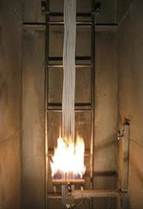|
CPR/Fire-safety cable
CPR Introduction
4. EuroClass Definition.
The CPR regulation introduces new classification criteria and common classes, the so called Euroclasses, for the entire European zone, creating a common language and a classification, assessment and certification system for all member countries, for construction products. With regards to fire behaviour, it permits establishing common standards to carry out assessment comparisons in equivalent conditions across the EU zone.
CPR establishes the characteristics that construction materials must satisfy with respect to fire. Therefore, cables are only affected by the safety specifications in the case of fire (resistance and reaction to fire) and hazardous substances (smoke emission and acidity content). The other technical characteristics are defined in the regular standards.
The EuroClass Relates mainly only to the Reaction to Fire performance of the cables. The fire reaction of a cable has the following relevant aspects:
Flame spread (EN 60332-1-2, EN 50399).
Heat release which is the main contribution to the fire pronation in the actual cable combustion (EN ISO 1716, EN 50399).

Flaming droplets for the burning particles given off (EN 50399).
Amount and transparency of Smoke emitted (EN 61034-2).
Acidity of the Gases given off (EN 60754)
We can define fire resistance as the capacity of a cable to maintain the electrical service of an installation during a fire. The greater fire resistance of a cable, the easier it will be to keep the emergency services in operation and therefore, permit evacuation. The standard that will develop this aspect is still in its draft phase.
Finally, the declaration of hazardous substances, their emission and content, indicates which components and in what proportion they are emitted in normal conditions of use, not of fire, by the cables, in order to preserve the environment. The fact that the content of hazardous substances has been taken into account will be indicated in the DoP of each product, although no criteria have yet been defined to determine them.
So for cable at present the most relevant aspect is reaction to fire. Fire resistance is still a pending regulation yet to be released.
Cables under CPR are tested and categorized from Class Aca (highest performance) to Fca (lowest performance). The most commonly accepted classes for public and commercial buildings are B2ca, Cca, and Dca, depending on the risk level and local regulations. The following table summarizes the Euroclass classification system under CPR, outlining the performance criteria, additional safety parameters and attestation of conformity required for each class. This system helps stakeholders assess and compare the fire performance of cables used in buildings.
| Construction inspection designation |
Class | Test procedure | Classification criteria |
Additional classification |
|---|---|---|---|---|
| Non-flammable | Aca |
EN ISO |
1716 PCS ≤ 2,0 |
|
| Flame-retardant |
B1ca |
EN 50399 (30 kW |
FS ≤ 1,75 m and THR1200s ≤ 10 |
Smoke generation and burning droplets/decreases and acid content |
B1ca |
EN 60332-1-2 |
H ≤ 425 mm |
||
| Flame-retardant |
B2ca |
EN 50399 (20,5 |
FS ≤ 1,5 m; and THR1200s ≤ 15 |
Smoke generation and burning droplets/decreases and acid content |
B2ca |
EN 60332-1-2 |
H ≤ 425 mm |
| Construction inspection designation |
Class | Test procedure | Classification criteria |
Additional classification |
|---|---|---|---|---|
| Flame-retardant |
Cca |
EN 50399 (20,5 |
FS ≤ 2,0 m; and THR1200s ≤ 30 |
Smoke generation and burning droplets/decreases and acid content |
Cca |
EN 60332-1-2 |
H ≤ 425 mm |
||
| Normally flammable |
Dca |
EN 50399 (20,5 |
THR1200s ≤ 70 |
Smoke generation and burning droplets/decreases and acid content |
Dca |
EN 60332-1-2 |
H ≤ 425 mm |
||
| Normally flammable |
Eca |
EN 60332-1-2 |
H ≤ 425 mm |
|
| Highly flammable |
Fca |
EN 60332-1-2 |
H > 425 mm |
|
Abbreviations
FIGRA Fire growth rate index used for classification purposes [W/s]
PCS PCS gross heat of combustion [MJ/kg]
THR1200s THR1200s total heat release (HRRsm30) from test start until end of test, excluding contribution from ignition source [MJ]
TSP1200s TSP1200s total smoke production (SPRsm60) from test start until end of test [m2]
Peak HRR Peak HRR = HRR = maximum value of heat release, excluding the burner output, determined during the whole burner application time, averaged over 30 s expressed in [kW]
Peak SPR Peak SPR = SPR = maximum value of smoke production, determined during the whole burner application time, averaged over 60 s, expressed in [m2/s]
FS FS vertical flame spread [m] equals the damaged length of the sample
H H vertical flame spread [mm] as defined in 3.1.17
m’ m’ mean value of the set of results of a continuous parameter determined in accordance with
the relevant test method using the minimum number of tests as specified in the test method
m m mean value of the set of results








